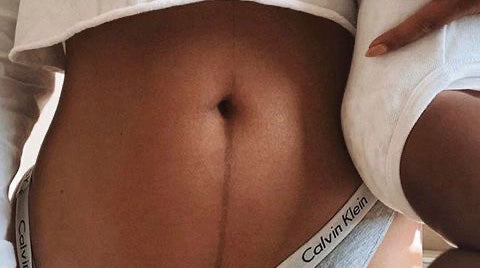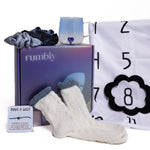Okay, so -- Your little bundle of joy is here!! EHHHH! And it was an exhausting, wild, joyful, anxious, messy ride and now you’re probably feeling a little… overwhelmed. Your body has undergone an incredible journey – make sure to give it some thanks and some rest, you did great!! – and now it's time to focus on your postpartum recovery.
So while your trying to navigate this new adventure, we’ve put together everything you need to know about getting through the first week of postpartum – so you can get back to being you!
Changes to Expect:
Okay okay… so what are some of the changes you might not expect in the first week? Let’s break it down from a woman who’s been there:
Soreness in the Perineum
First off – wtf is the perineum?! The perineum is the area between your vagina and anus – and it’s likely going to be sore and swollen after giving birth, especially if you had an episiotomy or experienced tearing. Totally normal – a human just came out of you, it’s going to leave some bumps and bruises in area’s you didn’t know could hurt.
Some really easy ways to ease pain / discomfort here:
- Practice Kegel exercises to strengthen your pelvic floor muscles.
- Apply a cold pack or ice wrapped in a towel to the perineal area.
- Use a pillow or donut-shaped cushion when sitting.
- Take warm baths to soothe the area.
- Wipe from front to back after using the bathroom to prevent infection – or even better, use a Perri Bottle so you don’t have to wipe!
- If it’s like reallllyyyy bad, just give your healthcare provider a quick call for more pain relief options.
Change in Vaginal Discharge
The ooy-gooey thing that never gets talked about is going to have some new tricks up it’s sleeve after brith! After giving birth, your body will naturally eliminate the excess blood and tissue that was used to nourish your baby. This may result in vaginal discharge that looks a little different than normal (blood, different colors, little blood clots, etc). Don’t stress too much over this change – your body knows what it needs to do to reset/cleanup and get back to ‘normal’.
Here's what you can do to keep things comfy:
- Use sanitary pads instead of tampons to avoid introducing bacteria and prevent infection – generally, try not to put anything ‘up there’ for a while. Consult your healthcare provider for how long to keep things ‘closed for business’ haha
- Change pads regularly.
- If you experience heavy or foul-smelling discharge, consult your healthcare provider.
Breast Engorgement and Nipple Pain
Your boobies might be feeling extra tender for the first few days postpartum (as if the pain wasn’t enough in T1 right?!). Its usually a result of your milk supply increasing/coming in – which like, cool!!!! It’s a super unique feeling to have never produced milk before and then all of a sudden you just – do?! CRAZY. This may cause tenderness and discomfort, which although annoying, can be managed pretty easily!
- Breastfeed your baby frequently to relieve pressure and stimulate milk flow.
- Express a small amount of milk before breastfeeding to soften the breast – it’s like .
- Take warm showers or apply warm towels to your breasts to encourage milk letdown.
- If your breasts leak between feedings, use nursing pads to keep your clothes dry.
- Consult a lactation consultant or your healthcare provider if you experience persistent nipple pain or difficulty with latch.
Sooooooo Much Swelling
If you thought popping baby out would release swelling and tension… think again!! The first week of postpartum brings lots of swelling in the hands, feet, and face due to fluid retention, all super normal (and super uncomfortable) but don’t worry, this goes away soon!! To alleviate swelling, try the following:
- Elevate your feet whenever possible.
- Wear loose-fitting and comfortable clothing.
- Stay cool and avoid excessive heat.
- Stay hydrated by drinking plenty of water.
On that note… Postpartum constipation can also be a common issue. To get things moving again try:
- Eat a diet rich in fiber, including fruits, vegetables, and whole grains.
- Drink plenty of water to soften stools.
- Consider using stool softeners under the guidance of your healthcare provider.
Peeing
Yup. Peeing is going to change. Going to the bathroom might come with some pain or difficulty urinating, or temporary incontinence (inability to pee). So just plan on having general issues with the bathroom for a few days – it’ll get better, promise!!!
- Drink plenty of water to stay hydrated and flush out toxins.
- Run water in the sink or take warm baths to stimulate urination.
- If problems persist, consult your healthcare provider.
Okay Last One… Hemorrhoids
Soooooooo not fun, but don’t be afraid. Hemorrhoids and swollen veins in the rectum… SUPER common. That whole area gets a lot of pressure so don’t worry as it sorts itself out! Dealing with them sucks (we’re not going to lie to you – never will!) but here’s how to make them suck less:
- Soak in a warm bath to reduce swelling.
- Ask your healthcare provider about over-the-counter sprays or creams for pain relief.
- Eat a high-fiber diet and drink plenty of water to soften stools.
- Avoid straining during bowel movements.
It would be an understatement to say that taking care of yourself is difficult in Trimester 4 – finding time (and energy) for self-care can be sooooo challenging. That’s why we boxed up all our essentials for making postpartum recovery a little easier and can have them delivered straight to your door – so you don’t even have to think about how to take care of yourself, we’ve got you!
Sending hugs,
rumbly






